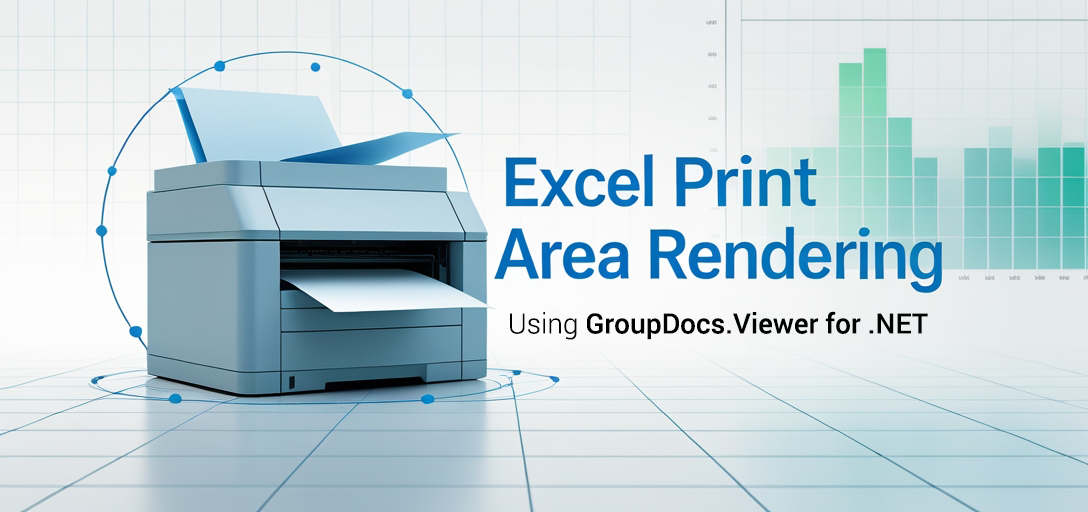Efficient Excel Print Area Rendering Using GroupDocs.Viewer for .NET
Introduction
Have you ever needed to display only certain sections of a large Excel spreadsheet, such as print areas, online? This can be challenging without the right tools. GroupDocs.Viewer for .NET is a robust library that simplifies document viewing and manipulation in your applications.
In this tutorial, we’ll explore how to render Excel print areas efficiently using GroupDocs.Viewer. You’ll learn how to enhance data presentation and save time when working with large spreadsheets. By the end of this guide, you’ll be proficient in setting up and executing print area rendering seamlessly.

What You’ll Learn:
- Setting up your environment for GroupDocs.Viewer for .NET
- Rendering Excel print areas using C#
- Configuring GroupDocs.Viewer to meet specific viewing requirements
Prerequisites
Before diving in, ensure you have the following:
- GroupDocs.Viewer Library: Version 25.3.0 or later.
- Development Environment: A .NET compatible IDE such as Visual Studio.
- Knowledge Base: Familiarity with C# and basic .NET development concepts.
Setting Up GroupDocs.Viewer for .NET
To begin, install the GroupDocs.Viewer library in your project using either NuGet Package Manager Console or the .NET CLI.
NuGet Package Manager Console:
Install-Package GroupDocs.Viewer -Version 25.3.0
.NET CLI:
dotnet add package GroupDocs.Viewer --version 25.3.0
License Acquisition
To fully utilize GroupDocs.Viewer, consider obtaining a license:
- Free Trial: Start with the trial version to test functionalities.
- Temporary License: For extended evaluation without limitations.
- Purchase: Acquire a commercial license for long-term use.
Once installed, initialize GroupDocs.Viewer in your project as shown below:
using GroupDocs.Viewer;
Implementation Guide
In this section, we’ll guide you through rendering Excel print areas. This feature allows you to extract and display only relevant portions of a spreadsheet.
Rendering Print Areas in Excel
Overview
Rendering specific print areas enhances performance by focusing on particular data sections, improving user experience for large datasets.
Step-by-Step Implementation
1. Set Up Your Environment
Firstly, ensure your output and document paths are correctly set:
string outputDirectory = Path.Combine("YOUR_OUTPUT_DIRECTORY");
string pageFilePathFormat = Path.Combine(outputDirectory, "page_{0}.html");
2. Initialize the Viewer Object
Create a Viewer object for your Excel file:
using (Viewer viewer = new Viewer(Path.Combine("YOUR_DOCUMENT_DIRECTORY", "SAMPLE_XLSX_WITH_PRINT_AREAS")))
{
// Continue with setup...
}
3. Configure HTML View Options
Set up HtmlViewOptions for embedded resources:
HtmlViewOptions options = HtmlViewOptions.ForEmbeddedResources(pageFilePathFormat);
4. Render Only Print Areas
Configure the options to render only print areas using SpreadsheetOptions:
options.SpreadsheetOptions = SpreadsheetOptions.ForRenderingPrintArea();
5. Execute Rendering
Use the View method to generate the output:
viewer.View(options);
Troubleshooting Tips
- Ensure paths are correctly set for both input and output directories.
- Verify that your Excel file contains defined print areas if you wish to render specific sections only.
Practical Applications
Rendering Excel print areas can be invaluable in several scenarios:
- Data Sharing: Share only relevant data segments with stakeholders, reducing clutter and focusing on key insights.
- Web Integration: Display selected spreadsheet parts seamlessly within web applications or portals.
- Document Management Systems: Integrate into systems where partial document views are essential.
Performance Considerations
When dealing with large spreadsheets:
- Limit the amount of data processed by rendering only necessary print areas.
- Manage memory usage effectively to prevent application slowdowns.
Adopt best practices for .NET memory management when using GroupDocs.Viewer.
Conclusion
You’ve now mastered how to render Excel print areas using GroupDocs.Viewer for .NET. This feature can streamline your data presentation workflows and enhance user experience by focusing on relevant information.
Next Steps:
- Explore other viewing features offered by GroupDocs.Viewer.
- Integrate this functionality into larger applications or systems you’re working with.
Ready to put your new skills to the test? Implement these steps in your next project!
FAQ Section
What is a print area in Excel? A print area defines specific sections of an Excel sheet set for printing, excluding other parts from being printed.
Can GroupDocs.Viewer render multiple print areas? Yes, it can handle multiple defined print areas within a single spreadsheet file.
Do I need any additional software to use GroupDocs.Viewer? No, as long as your development environment supports .NET and you have the library installed, you’re set.
How does rendering performance impact application speed? Rendering only necessary areas can enhance performance by reducing data processing requirements.
What are some common errors when using GroupDocs.Viewer for Excel files? Common issues include incorrect file paths or missing print area definitions in the spreadsheet.
Resources
- Documentation: GroupDocs Viewer .NET Documentation
- API Reference: GroupDocs API Reference
- Download: GroupDocs Downloads
- Purchase: Buy GroupDocs License
- Free Trial: Try GroupDocs Viewer for .NET Free Trial
- Temporary License: Obtain Temporary License
- Support: GroupDocs Support Forum
Embark on your journey to efficient document rendering with GroupDocs.Viewer for .NET today!